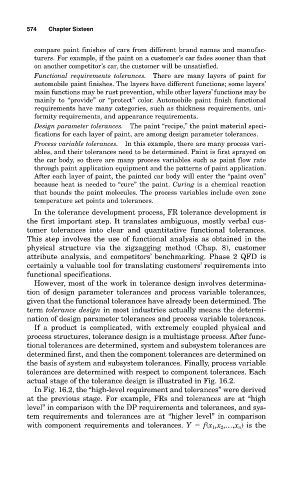Page 621 - Design for Six Sigma a Roadmap for Product Development
P. 621
574 Chapter Sixteen
compare paint finishes of cars from different brand names and manufac-
turers. For example, if the paint on a customer’s car fades sooner than that
on another competitor’s car, the customer will be unsatisfied.
Functional requirements tolerances. There are many layers of paint for
automobile paint finishes. The layers have different functions; some layers’
main functions may be rust prevention, while other layers’ functions may be
mainly to “provide” or “protect” color. Automobile paint finish functional
requirements have many categories, such as thickness requirements, uni-
formity requirements, and appearance requirements.
Design parameter tolerances. The paint “recipe,” the paint material speci-
fications for each layer of paint, are among design parameter tolerances.
Process variable tolerances. In this example, there are many process vari-
ables, and their tolerances need to be determined. Paint is first sprayed on
the car body, so there are many process variables such as paint flow rate
through paint application equipment and the patterns of paint application.
After each layer of paint, the painted car body will enter the “paint oven”
because heat is needed to “cure” the paint. Curing is a chemical reaction
that bounds the paint molecules. The process variables include oven zone
temperature set points and tolerances.
In the tolerance development process, FR tolerance development is
the first important step. It translates ambiguous, mostly verbal cus-
tomer tolerances into clear and quantitative functional tolerances.
This step involves the use of functional analysis as obtained in the
physical structure via the zigzagging method (Chap. 8), customer
attribute analysis, and competitors’ benchmarking. Phase 2 QFD is
certainly a valuable tool for translating customers’ requirements into
functional specifications.
However, most of the work in tolerance design involves determina-
tion of design parameter tolerances and process variable tolerances,
given that the functional tolerances have already been determined. The
term tolerance design in most industries actually means the determi-
nation of design parameter tolerances and process variable tolerances.
If a product is complicated, with extremely coupled physical and
process structures, tolerance design is a multistage process. After func-
tional tolerances are determined, system and subsystem tolerances are
determined first, and then the component tolerances are determined on
the basis of system and subsystem tolerances. Finally, process variable
tolerances are determined with respect to component tolerances. Each
actual stage of the tolerance design is illustrated in Fig. 16.2.
In Fig. 16.2, the “high-level requirement and tolerances” were derived
at the previous stage. For example, FRs and tolerances are at “high
level” in comparison with the DP requirements and tolerances, and sys-
tem requirements and tolerances are at “higher level” in comparison
with component requirements and tolerances. Y f(x 1 ,x 2 ,…,x n ) is the

